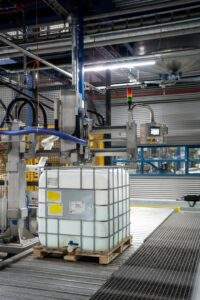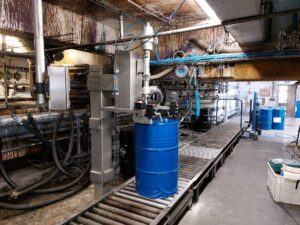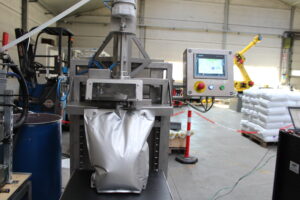Umicore Bruges
This solution in a nutshell:
- Filling of IBCs, drums, barrels and water bottles
- Chemical sector
- Top and bottom mirror filling
- ATEX environment
- Supply and disposal of empty and filled IBCs and pallets
via roller conveyors (also in ATEX Zone)
Why the customer chose Robbe Industries….
- Automation
- Flexible and customized for the customer
- Viscous liquids: silicones, adhesives, syrups…
- Paints and Alkyd resins
Customer data
Company
Umicore Bruges
Website
www.umicore.be
State-of-the art filling line for chemical products at Umicore Bruges.
Umicore Brugge and Robbe Industries go back a long way. For decades, Robbe Industries has supplied all filling and weighing applications for this renowned chemical company.
To fill IBCs and drums in a cost-effective and ergonomic manner, Robbe Industries was called upon to design and build a filling line for liquid products. Filling by weight of IBCs and drums is done automatically by the weighing control.
The filling line is used in an ATEX zone , but due to the years of experience of Robbe Industries’ engineering, this was not a problem.
The supply and removal of IBCs and containers is done via automated roller conveyors controlled by a central PLC. The Siemens controller also handles the filling process.
Umicore in Bruges is known as a reputable producer of, among other things, metal carboxylates, the dryers for paints and printing inks that can also be used as catalysts in other chemical processes, and alkyd resins, the binders found in those same paints. Since many of these molecules can also be used for other high-quality applications, such as lubricating oils or tires, for example, attempts have been made for some time to significantly broaden the range. To properly support this diversification, they recently decided to invest in a new, state-of-the-art filling line and ditto roller conveyor.
Need for modern filling line
Back in time
Since 1985, Umicore Specialty Materials has been located on a site at the very end of Kleine Pathoekweg in Bruges. About 90% of the 3 to 400 different end products at Umicore Brugge are liquid and thus leave the site via tankers, either in 1,000-liter IBCs or 200-liter drums, with an order of magnitude of about 20,000 drums and 5 to 6,000 IBCs per year. The plant, which until recently was only responsible for filling each finished product, dates back to when the plant was conceived. In other words, she has a respectable 35 years on the clock anyway, albeit with some (non-fundamental) adjustments here and there over the years.
“Filling still required quite a lot of manual intervention by our operators,” says Bram Damman, project manager at Umicore Brugge.
“Barrels had to be manually lifted from the pallets, and then placed on a belt. After positioning the opening of the barrel under the filling head and the – admittedly semi-automatic – filling itself, the barrels again had to be placed in pairs on a pallet by means of the forklift truck, and finally they had to be tied down. In addition to the many manipulations, not infrequently resulting in damaged drums, the filling line also seemed to be tucked away in a dark corner, dating back to a time when ergonomics for blue-collar workers was not yet given much attention. So the situation was far from optimal. And so we conceived the idea of investing in a new filling line, state-of-the-art.”
Expansion in 2015
Although the need had been there for a while, the path to a suitable solution would eventually take its time. “About four years? At least longer than predetermined,” Damman confessed. “The main reason for this was that we were able to purchase the adjacent building in 2015, and hoped to use this space as a new central warehouse in accordance with a logistics master plan. When an external consultant mapped out all the logistics flows when this plan was being drawn up, it became clear that a lot of useless miles were being traveled for filled products. For this reason, the initial plan for a replacement investment for the old filling line at the original location evolved into an expansion investment for a new filling line at a new, more logical location.” And that new location would eventually turn out to be next to the new nearby building, with the intention of being able to direct IBCs and drum pallets toward storage efficiently and, preferably, automatically.”
Solution
More than just filling In line with the proposed master plan, the investment would ultimately be about much more rotate than merely a modern filling unit, but also to several roller conveyors, a turntable and an automatic pallet wrapper. The solution would eventually come through attribution from Robbe Industries, an old love of Umicore Brugge. Indeed, in addition to virtually every scale and a few pallet weighers, Robbe Industries also realized a number of smaller filling installations for Umicore Brugge in the past.
Filling process via under-mirror filling
In the solution, an empty IBC or drum is positioned on the roller conveyor which is weighted. When the operator presses start after positioning the lance in the XY plane, the IBC or drum pallet is tared, after which the filling process can begin. The head of the filling lance invariably moves along during this process, just below the surface of the medium (under-mirror filling). In this way, there is no turbulence in the product, nor can foam build up that would increase the risk of product loss. In addition, there will also be no splashes visible on the inside of the IBC, which in turn is an aesthetic advantage: it looks neater. On the product itself, foam formation has no consequences. Another option would be to bring down the filling speed, but this would obviously also reduce the efficiency of the filling line proportionally. The programming of the sophisticated filling process would eventually be done in-house by Robbe Industries’ programmers.
ATEX and the Machinery Directive
To be in line with ATEX standards, the filling line is equipped with an extraction head with fan. This allows any explosive gases – the line is in a Zone 1 and around the filling head there is a, albeit minor, Zone 2 – to be evacuated immediately. The fan itself is connected to the safety PLC to prevent operators from filling when the fan is not running. Safety is also built in regarding possible static discharges. A light on the control panel indicates whether a vessel is grounded or not (via special pliers). Only when this is the case can the filling process begin. An extra safety, so to speak.
Cleaning
Although there are not many products within Umicore Brugge that can cause contamination , it is still important – especially for the products supplied through long or heated supply lines – to frequently go through a CIP flushing circuit in order to completely eliminate the (minimal) risk of cross-contamination. Furthermore, the filling lance can also be placed in a special holder after each filling for cleaning.
Advantages
The choice of a new, modern filling line and automated transport via roller conveyors eliminates both product loss and the often unnecessary driving of forklifts from the filling line to the warehouse.
Operators can spend their time more usefully this way. Moreover, it is also a lot more pleasant work for them.
How can we help you?
Describe your project and needs through our form and we will let you know, without obligation, how we can help you within two business days!
View more realizations

Filling lines for filling IBCs and drums at SABA
Filling doypacks small package with highly viscous product

Filling plant Umicore Bruges
Filling machine in an ATEX zoning for different types of resin and hydrocarbon.

Atlas filling device for doypacks with glue roll
Filling doypacks, small packages, with very viscous product.
What can we help you?
Describe your project and needs through our form and we will let you know, without obligation, how we can help you within two business days!
